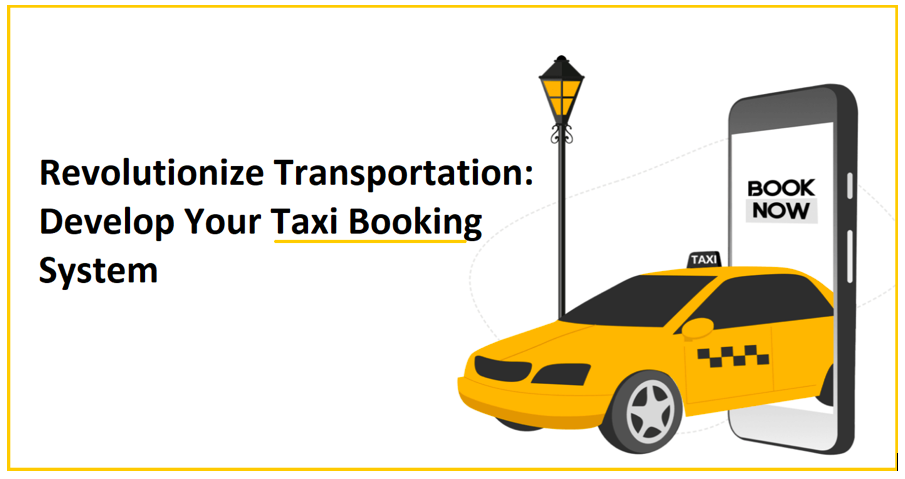Transportation is vital in our daily lives in today’s fast-paced world. With the increasing popularity of ride-hailing services, it’s no surprise that developing your taxi booking system can revolutionize how people travel.
The above statistics show that the ride-hailing business has been growing significantly for a few years and is expected even to grow more. Thus, in this article will guide you through creating a taxi booking system that caters to the modern needs of customers, providing convenience, efficiency, and an enhanced user experience.
 The traditional approach of hailing a taxi on the street or making a phone call to a cab company is gradually being replaced by digital solutions. A taxi booking system allows users to book rides effortlessly using a mobile application or a website, connecting passengers with nearby drivers. This streamlined process eliminates waiting on the street for a cab, making transportation more convenient and efficient.
The traditional approach of hailing a taxi on the street or making a phone call to a cab company is gradually being replaced by digital solutions. A taxi booking system allows users to book rides effortlessly using a mobile application or a website, connecting passengers with nearby drivers. This streamlined process eliminates waiting on the street for a cab, making transportation more convenient and efficient.
Contents
The Need for a Taxi Booking System
The demand for taxi booking systems stems from the desire for a more efficient and user-friendly transportation experience. Traditional taxi services often suffer from long wait times, unavailability during peak hours, and unreliable fare estimations. By developing your taxi booking system, you can address these pain points and provide a seamless solution that enhances the overall customer experience.
Also Read:- 5 Important Tips to Enjoy a Long Trip
Key Features of a Taxi Booking System
To ensure the success of your taxi booking system, it’s crucial to incorporate key features that meet the expectations of modern users. These features include:
Real-time Vehicle Tracking
Integrating GPS technology allows users to track the location of their assigned vehicle in real time. This feature provides transparency and helps passengers estimate the arrival time accurately, enhancing their overall experience.
Multiple Payment Options
Offering a variety of payment methods, such as credit cards, mobile wallets, or cash, gives users flexibility and convenience. It’s important to integrate secure payment gateways to ensure the safety of transactions.
User-friendly Interface
A user-friendly interface is essential for a taxi booking system. The application or website should be intuitive, easy to navigate, and visually appealing. Clear and concise instructions and logical placement of buttons and menus contribute to a seamless user experience.
Rating and Feedback System
Integrating a rating and feedback system allows users to provide feedback on their ride experience and rate drivers. This feature helps maintain service quality and allows users to make informed decisions when choosing a driver.
Benefits of Developing Your Taxi Booking System
Developing your own taxi booking system offers several advantages as it creates better revenues by wide-spreading the service reach across multiple countries with complete currency change and live operation management that can revolutionize transportation services:
Data Analysis and Business Insights
A well-developed taxi booking system captures valuable data on user preferences, popular routes, peak hours, and other relevant metrics. By leveraging this data, you can gain insights into customer behavior, optimize pricing strategies, and make data-driven decisions to improve your business operations.
Branding and Competitive Advantage
Having your taxi booking system establishes your brand presence in the market. With a unique app or website, you can differentiate yourself from competitors and build a strong brand image. This competitive advantage can attract more users and help you establish a strong foothold in the transportation industry.
Enhanced Customer Experience
By providing a user-friendly interface, real-time vehicle tracking, and multiple payment options, you can offer a superior customer experience. Users will appreciate your system’s convenience, transparency, and efficiency, leading to increased customer satisfaction and loyalty.
Steps to Develop a Taxi Booking System
Developing a taxi booking system requires careful planning and execution. Here are the key steps involved in the development process:
Define Requirements and Goals
Clearly define the requirements and goals of your taxi booking system. Identify the target audience, key features, and specific functionalities you want to incorporate. This step ensures that your development process remains focused and aligned with your business objectives.
Read also:- How To Reach Out To The Right Audience On Instagram?
Choose the Right Technology Stack
Selecting the appropriate technology stack is crucial for the success of your taxi booking system. Consider scalability, security, platform compatibility, and development resources. Popular technology for building taxi booking systems includes frameworks like React Native or Flutter for mobile applications and languages like Python or Node.js for backend development.
Design the User Interface and User Experience
Create a visually appealing and user-friendly interface for your application or website. Pay attention to color schemes, typography, and intuitive navigation. Conduct user testing to ensure that the design meets the expectations of your target audience.
Develop the Backend Functionality
Build the backend of your taxi booking system, including user authentication, driver management, ride-matching algorithms, and payment integration. Choose a robust backend framework that can handle high volumes of requests and provide a seamless experience for users.
Implement Real-time Tracking and Payment Integration
Integrate GPS-based real-time vehicle tracking to provide users with accurate information on driver location and estimated arrival time. Additionally, integrate secure payment gateways to facilitate smooth and secure transactions.
Test and Launch the System
Test your taxi booking system thoroughly to ensure its functionality, performance, and security. Conduct beta testing with a limited user base to gather feedback and make necessary improvements. Once satisfied with the results, launch your system to the public and monitor its performance closely.
Challenges and Solutions in Developing a Taxi Booking System
While developing a taxi booking system, you may encounter several challenges. Here are some common challenges and their corresponding solutions:
Security and Privacy Concerns
Security and privacy are crucial aspects of any online platform. Implement robust security measures such as data encryption, secure authentication protocols, and regular security audits. Comply with data protection regulations and educate users about the steps taken to safeguard their personal information.
Scalability and Performance
As your taxi booking system gains popularity, it’s essential to ensure its scalability and performance. Optimize the codebase, use caching mechanisms, and leverage cloud infrastructure to handle increasing user loads. Monitor system performance regularly and address any bottlenecks promptly.
Seamless Integration with Third-party Services
Integrating third-party services, such as mapping APIs or payment gateways, can pose challenges. Choose reliable service providers and thoroughly test the integration points. Keep track of any updates or changes from third-party services to maintain seamless functionality.
Case Study: Success Stories of Taxi Booking Systems
To understand the potential impact of a well-developed taxi booking system, let’s look at a few success stories:
Uber
Uber revolutionized the transportation industry with its user-friendly app, real-time tracking, and cashless payments. By offering a convenient and reliable ride-hailing service, Uber became a global phenomenon and transformed how people travel.
Lyft
Lyft is another successful taxi booking system that gained popularity by focusing on providing a friendly and personalized experience. With features like in-app tipping and community initiatives, Lyft built a strong brand image and gained a loyal user base.
Grab
Grab, originally founded as a taxi booking system, expanded its services to include ride-hailing, food delivery, and more. By catering to the diverse needs of users across Southeast Asia, Grab became a dominant player in the region’s transportation market.
Conclusion
Developing your own taxi booking system can revolutionize transportation services by offering convenience, efficiency, and an enhanced user experience. By incorporating key features, addressing challenges, and following a systematic development process, you can create a successful platform that meets the needs of modern users. Embrace the opportunities offered by technology and embark on the journey of transforming the way people travel.
FAQs
Here are some frequently asked questions about developing a taxi booking system:
Is it expensive to develop a taxi booking system?
The cost of developing a taxi booking system can vary depending on features, complexity, and development resources. It’s advisable to consult with experienced developers or development agencies to get a more accurate estimate.
How long does it take to develop a taxi booking system?
The development timeline for a taxi booking system depends on various factors, including the scope of the project and the availability of resources. A well-planned and executed development process can take several months to complete.
Do I need to have technical knowledge to develop a taxi booking system?
While technical knowledge can be helpful, it’s not mandatory to have in-depth technical expertise to develop a taxi booking system. Collaborating with experienced developers or development teams can bridge the technical gap and ensure a successful development process.



